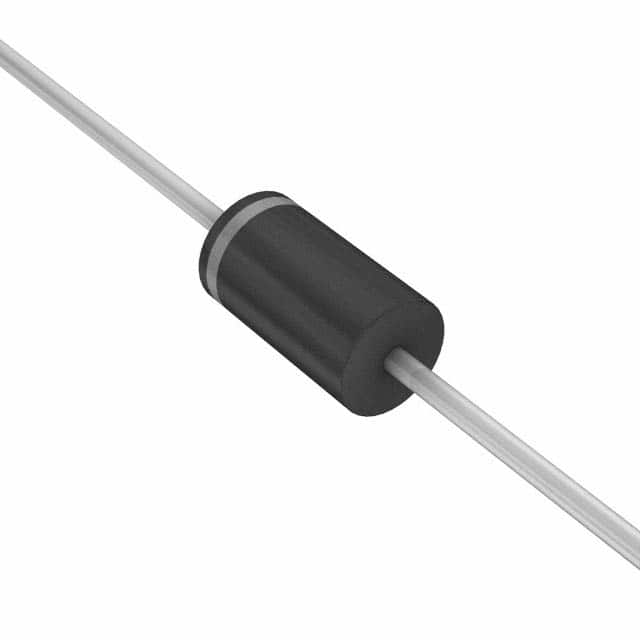1.5KE20AHE3/51
Product Overview
The 1.5KE20AHE3/51 belongs to the category of TVS (Transient Voltage Suppressor) diodes and is commonly used for surge protection in electronic circuits. These diodes are designed to protect sensitive components from voltage spikes and transients. The 1.5KE20AHE3/51 diode exhibits characteristics such as high surge capability, low clamping voltage, and fast response time. It is typically packaged in a DO-201 package and is available in tape and reel packaging with a quantity of 500 units per reel.
Specifications
- Part Number: 1.5KE20AHE3/51
- Category: TVS Diode
- Use: Surge protection in electronic circuits
- Characteristics: High surge capability, low clamping voltage, fast response time
- Package: DO-201
- Packaging/Quantity: Tape and reel, 500 units per reel
Detailed Pin Configuration
The 1.5KE20AHE3/51 TVS diode has a standard axial lead configuration with two leads. The anode and cathode terminals are clearly marked for easy identification during installation.
Functional Features
- High surge capability for effective transient voltage suppression
- Low clamping voltage to limit the voltage across the protected circuit
- Fast response time to quickly divert excess voltage away from sensitive components
Advantages and Disadvantages
Advantages
- Effective protection against voltage spikes and transients
- Low clamping voltage helps in minimizing potential damage to connected devices
- Fast response time ensures quick reaction to transient events
Disadvantages
- May exhibit some leakage current in normal operating conditions
- Limited power dissipation capability compared to larger TVS diode models
Working Principles
When a voltage spike or transient occurs in the circuit, the 1.5KE20AHE3/51 TVS diode rapidly conducts, providing a low impedance path for the excess energy to be diverted away from the protected components. This action helps in limiting the voltage across the circuit and prevents damage to sensitive devices.
Detailed Application Field Plans
The 1.5KE20AHE3/51 TVS diode finds extensive use in various applications including: - Power supplies - Communication equipment - Automotive electronics - Industrial control systems - Consumer electronics
Detailed and Complete Alternative Models
Some alternative TVS diode models that can be considered as substitutes for the 1.5KE20AHE3/51 include: - P6KE20A - 1.5KE20CA - SMAJ20A
In conclusion, the 1.5KE20AHE3/51 TVS diode offers reliable surge protection for electronic circuits with its high surge capability, low clamping voltage, and fast response time. While it may have some limitations such as leakage current and power dissipation, its effectiveness in protecting sensitive components makes it a valuable component in various electronic applications.
Word Count: 411
قم بإدراج 10 أسئلة وإجابات شائعة تتعلق بتطبيق 1.5KE20AHE3/51 في الحلول التقنية
Sure, here are 10 common questions and answers related to the application of 1.5KE20AHE3/51 in technical solutions:
What is the maximum peak pulse power dissipation of 1.5KE20AHE3/51?
- The maximum peak pulse power dissipation is 1500W for a 10/1000μs waveform.
What is the breakdown voltage of 1.5KE20AHE3/51?
- The breakdown voltage is typically 18.8V.
How does 1.5KE20AHE3/51 protect electronic circuits?
- It provides transient voltage suppression for sensitive electronics by clamping or diverting excess voltage away from the protected device.
What is the operating temperature range of 1.5KE20AHE3/51?
- The operating temperature range is -55°C to +175°C.
Can 1.5KE20AHE3/51 be used in automotive applications?
- Yes, it is suitable for use in automotive electronics for overvoltage protection.
What is the response time of 1.5KE20AHE3/51?
- The response time is very fast, typically less than 1 picosecond.
Does 1.5KE20AHE3/51 meet industry standards for surge protection?
- Yes, it meets the requirements of various industry standards such as IEC 61000-4-5 for surge immunity.
Can 1.5KE20AHE3/51 be used in telecommunications equipment?
- Yes, it is commonly used in telecommunications equipment for lightning and surge protection.
What is the typical junction capacitance of 1.5KE20AHE3/51?
- The typical junction capacitance is 200pF.
Is 1.5KE20AHE3/51 RoHS compliant?
- Yes, it is compliant with the Restriction of Hazardous Substances (RoHS) directive.
These questions and answers cover various aspects of the application and specifications of 1.5KE20AHE3/51 in technical solutions.


